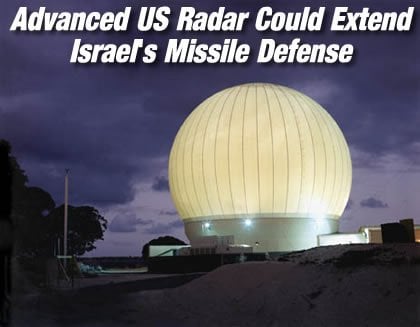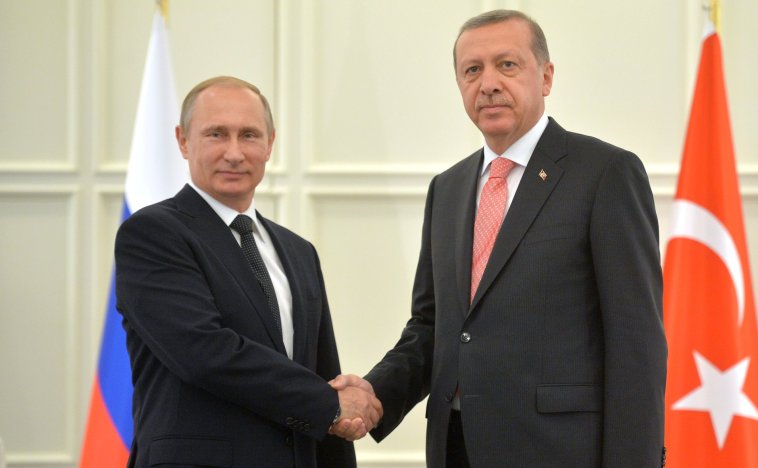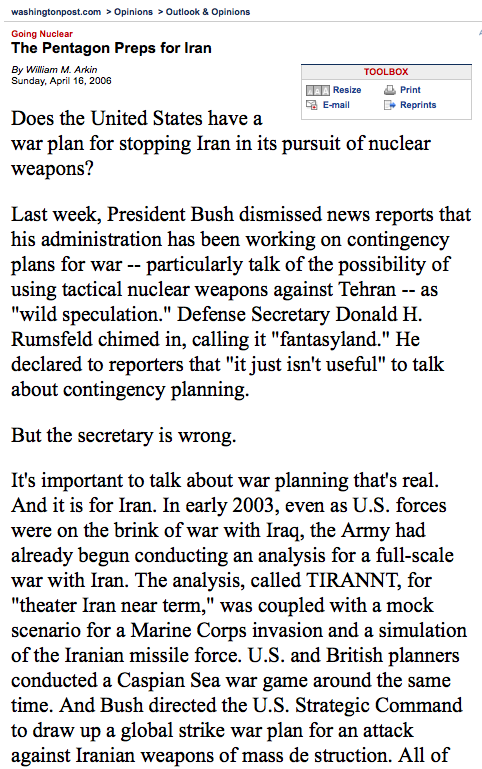
Illustrative image
Written by Prof Michel Chossudovsky; Originally appeared at Global Research
In 2003, the war on Iran project was already Déjà Vu. It had been on the drawing board of the Pentagon since the mid-nineties.
Since the launching of the Theater Iran Near Term (TIRANNT) war games scenario in May 2003 (leaked classified document), an escalation scenario involving military action directed against Iran and Syria had been envisaged, of which Syria was the first stage in 2011.
The initial invasion of Iraq under “Operation Iraqi Freedom” was launched on March 20, 2003, April 9 marks the Fall of Baghdad; officially the invasion was completed on May 1st, 2003.
In May 2003, immediately following the invasion and occupation of Iraq, the TIRANNT (Theater Iran Near Term) war games scenario were carried out as revealed by William Arkin, a former US intelligence analyst:
“In early 2003, even as U.S. forces were on the brink of war with Iraq, the Army had already begun conducting an analysis for a full-scale war with Iran. The analysis, called TIRANNT, for “theater Iran near term,” was coupled with a mock scenario for a Marine Corps invasion and a simulation of the Iranian missile force. U.S. and British planners conducted a Caspian Sea war game around the same time. And Bush directed the U.S. Strategic Command to draw up a global strike war plan for an attack against Iranian weapons of mass destruction. All of this will ultimately feed into a new war plan for “major combat operations” against Iran that military sources confirm now exists in draft form. [This contingency plan entitled CONPLAN 8022 would be activated in the eventuality of a Second 9/11, on the presumption that Iran would be behind it] (William Arkin, Washington Post, 16 April 2006)
Screenshot of WPo article, opinion section
“Theater Near Term”, a scenario of waging a war against Iran following the defeat of Iraq was the unspoken concept. Under the auspices of US Central Command, TIRANNT focussed on both “Near Term” (i.e. following the Iraq war) as well “Out-Year” (signifying the subsequent year) scenarios for war with Iran ” …including all aspects of a major combat operation, from mobilization and deployment of forces through postwar stability operations after regime change.” (Ibid)
The core TIRANNT effort began in May 2003, when modelers and intelligence specialists pulled together the data needed for theater-level (meaning large-scale) scenario analysis for Iran. TIRANNT has since been updated using post-Iraq war information on the performance of U.S. forces. Meanwhile, Air Force planners have modeled attacks against existing Iranian air defenses and targets, while Navy planners have evaluated coastal defenses and drawn up scenarios for keeping control of the Strait of Hormuz at the base of the Persian Gulf.A follow-on TIRANNT Campaign Analysis, which began in October 2003, calculated the results of different scenarios for action against Iran to provide options for analyzing courses of action in an updated Iran war plan. (Ibid)
Needless to say, the “Near Term” plans formulated in 2003 had been postponed.
USCENTCOM’s “Dual Containment”. First Iraq, then Iran
The 2003 decision to target Iran under TIRANNT as well as all subsequent endeavors and “secret plans” were part of the broader Middle East military roadmap. Already during the Clinton administration, US Central Command (USCENTCOM) had formulated in 1995 under the doctrine of “Dual Containment” “in war theater plans” to invade first Iraq and then Iran:
“The broad national security interests and objectives expressed in the President’s National Security Strategy (NSS) and the Chairman’s National Military Strategy (NMS) form the foundation of the United States Central Command’s theater strategy. The NSS directs implementation of a strategy of dual containment of the rogue states of Iraq and Iran as long as those states pose a threat to U.S. interests, to other states in the region, and to their own citizens. Dual containment is designed to maintain the balance of power in the region without depending on either Iraq or Iran. USCENTCOM’s theater strategy is interest-based and threat-focused. The purpose of U.S. engagement, as espoused in the NSS, is to protect the United States’ vital interest in the region – uninterrupted, secure U.S./Allied access to Gulf oil.”emphasis added, the original document of USCENTCOM is no longer available)
The Role of Israel. “Doing the Bombing For Us”
The TIRANNT (2003) scenario was followed by a series of military plans pertaining to Iran. Numerous post 9/11 official statements and US military documents had pointed to an expanded Middle East war, involving the active participation of Israel.
Broadly, what characterizes U.S. foreign policy is to encourage America’s allies “to do the dirty work on our behalf”.
 At the outset of Bush’s Second Term, Vice President Dick Cheney dropped a bombshell, hinting, in no uncertain terms, that Iran was “right at the top of the list” of the rogue enemies of America, and that Israel would, so to speak, “be doing the bombing for us”, without US military involvement and without us putting pressure on them “to do it”.
At the outset of Bush’s Second Term, Vice President Dick Cheney dropped a bombshell, hinting, in no uncertain terms, that Iran was “right at the top of the list” of the rogue enemies of America, and that Israel would, so to speak, “be doing the bombing for us”, without US military involvement and without us putting pressure on them “to do it”.
In contrast, under the Trump administration, according to Professor James Petras, Israel and the Zionist Lobby are playing an active role, pressuring President Trump to take the first step:
“Israeli Prime Minister Benjamin Netanyahu and the Presidents of the 52 Major Jewish American Organizations are leading President Trump, like a puppy on a leash, into a major war with Iran. The hysterical ’52 Presidents’ and ‘Bibi’ Netanyahu are busy manufacturing Holocaust-level predictions that a non-nuclear Iran is preparing to ‘vaporize’ Israel, , The buffoonish US President Trump has swallowed this fantasy wholesale and is pushing our nation toward war for the sake of Israel and its US-based supporters and agents. (James Petras, Global Research, October 27, 2017)
Who are the Main Actors?
Political rhetoric is often misleading. Israel is America’s ally. Military operations are closely coordinated. Tel Aviv is however subordinate to Washington. In major military operations, Israel does not act without the Pentagon’s approval.
Barely acknowledged by the media, the US and Israel have an integrated air defense system, which was set up in early 2009, shortly after the Israel invasion of Gaza under “Operation Cast Led”.
The X-band radar air defense system set up by the US in Israel in 2009 would “integrate Israel’s missile defenses with the U.S. global missile detection network, which includes satellites, Aegis ships on the Mediterranean, Persian Gulf and Red Sea, and land-based Patriot radars and interceptors.” (Sen. Joseph Azzolina, Protecting Israel from Iran’s missiles, Bayshore News, December 26, 2008). )
What this means is that Washington calls the shots. Confirmed by the Pentagon, the US military controls Israel’s Air Defense:
”This is and will remain a U.S. radar system,’ Pentagon spokesman Geoff Morrell said. ‘So this is not something we are giving or selling to the Israelis and it is something that will likely require U.S. personnel on-site to operate.’” (Quoted in Israel National News, January 9, 2009, emphasis added).
 At the outset of Obama’s Second Term, the US and Israel initiated discussions pertaining to a “US personnel on site” presence in Israel, namely the establishment of a “permanent” and “official” military base inside Israel. And on September 17, 2017, a US Air Defense base located in the Negev desert was inaugurated. According to the Israeli IDF spokesperson, the objective is to send a “message to the region, ” including Iran, Lebanon, Syria and Palestine.
At the outset of Obama’s Second Term, the US and Israel initiated discussions pertaining to a “US personnel on site” presence in Israel, namely the establishment of a “permanent” and “official” military base inside Israel. And on September 17, 2017, a US Air Defense base located in the Negev desert was inaugurated. According to the Israeli IDF spokesperson, the objective is to send a “message to the region, ” including Iran, Lebanon, Syria and Palestine.
Israel would not be able to act unilaterally against Iran, without a green light from the Pentagon which controls key components of Israel’s air defense system.
In practice, a war on Iran, were it to occur would be a joint US-Israeli endeavor, coordinated by US Strategic Command (STRATCOM) with America’s allies playing a key (subordinate) role.
The Evolving Structure of Military Alliances
Since the formulation of USCENTCOM’s “in war theater” plans in the mid-nineties, and more specifically since the onslaught of the war on Syria in 2011, the geopolitics of the broader Middle East Central Asian region has evolved dramatically with Russia and China taking on a major role.
In this regard, the shift in the structure of military alliances has served to weaken US influence. Iran is now supported by a powerful China-Russia block. In turn, Pakistan and India have joined the Shanghai Cooperation Organization (SCO), which has contributed to undermining US-Pakistani relations.
In turn, Iran’s bilateral relations with China including strategic oil, gas and pipeline deals (as well as military cooperation) have developed since President Xi Jinping took office in 2012.
Moreover, while Tehran has reached a “pact of convenience” with Ankara, the unity of Saudi Arabia and the Gulf States is now in jeopardy, with Qatar, Oman and Kuwait building an alliance with Iran, to the detriment of Saudi Arabia and the UAE.
Since the war on Syria, Iran has not only established a strong bilateral relationship with Syria, it has also reinforced its ties with Lebanon and Yemen.
In other words, US hegemony is threatened in the broader Middle East Central Asian region. The structure of alliances and “cross-cutting coalitions” in 2018 does not favor a US-led military operation against Iran.
- The Atlantic Alliance is in crisis and so is the Gulf Cooperation Council (GCC).
- The US and Turkey are clashing in Northern Syria, where Turkey is fighting US sponsored Kurdish rebels.
- Turkey, which constitutes NATO’s heavyweight (in terms of conventional forces) has acquired Russia’s S400 air defense system. Does this signify that Turkey (as a member state of the Atlantic Alliance) no longer fully shares the US-NATO-Israel defense system?
 Another consideration is Turkey’s rapprochement with both Russia and Iran.
Another consideration is Turkey’s rapprochement with both Russia and Iran.
presidents Putin and Erdogan (right)
Demise of the “Triple Alliance”: US, Israel, Turkey
How does Turkey’s “pact of convenience” with Iran affect the Israel-Turkey Security and Secrecy Agreement (SSA) launched by the Tansu Çiller government in 1994?
The SSA agreement was a carefully designed instrument of US foreign policy (sponsored by the Clinton administration) which set the stage for a firm and close Israel-Turkey relationship in military and intelligence cooperation, joint military exercises, weapons production and training.
The SSA largely served US strategic interests in the Middle East. The intent of the SSA Israel-Turkey bilateral military-intelligence agreement was to create a triangular relationship between the US, Israel and Turkey. This de facto (rather than de jure) “triple alliance”, under the helm of the Pentagon, was intended to integrate and coordinate military command decisions (as well as intelligence) between the three countries pertaining to the broader Middle East.
From a strategic standpoint, the Pentagon was intent upon “using” both Israel and Turkey in Middle East military operations (i.e to act on our behalf).
The “Triple alliance” was based on close (bilateral) military ties respectively between Israel and Turkey with the US, coupled with a strong bilateral military relationship between Tel Aviv and Ankara.
In turn, Israel signed a far-reaching military cooperation protocol with NATO in March 2005 in Jerusalem. Under this agreement, Israel had become a de facto member of NATO. The 2005 Israel-NATO bilateral military cooperation agreement was viewed by the Israeli military as a means to “enhance Israel’s deterrence capability” against Iran, which has recently entered into an alliance of convenience with Turkey, a NATO member state. Sounds contradictory?
It is also worth noting Israel’s longstanding membership in NATO’s Mediterranean Dialogue together with six other non-NATO member states: Algeria, Egypt, Jordan, Mauritania, Morocco and Tunisia. Recently, these six countries have taken a stance against Israel in the wake of Trump’s decision to move the US embassy to Jerusalem.
It was no coincidence that the Mediterranean Dialogue (MD) was launched in the same year as the Israel-Turkey SSA agreement (1994).
- Is the Israel-Turkey SSA agreement currently in jeopardy?
- Following Trump’s Jerusalem Statement, the Mediterranean Dialogue is also in crisis, to the detriment of Washington.
- How can joint military and intelligence operations directed against Iran be carried out when Turkey (a NATO member state and an ally of Israel) is “in bed with the enemy”?
- Another consideration is the de facto demise of GUUAM (Georgia, Ukraine, Uzbekistan, Azerbaijan and Moldova), a loose US-NATO sponsored military alliance of five former Soviet republics created in 1999, slated to be used against Russia and Iran.
For the above reasons, the Pentagon’s TIRANNT “Near Term” scenario of a conventional war against Iran at this juncture is unlikely.
While a conventional war on Iran is currently on hold, the US has indelibly opted for nonconventional warfare including destabilization, economic sanctions, infiltration, cooptation and regime change.
The Pentagon, nonetheless retains its longtime strategic option of inducing its closest allies including Saudi Arabia and Israel to “wage war on its behalf”.
We are nonetheless at a dangerous crossroads in our history. While Pentagon analysts are fully aware that the US cannot win a conventional war against Iran, a first strike tactical nuclear weapons attack is still “on the table”. So are intelligence ops, the recruitment of hired “jihadist” terrorists, the funding of insurgencies, etc. (not to mention the use of a panoply of nonconventional weapons systems including electromagnetic, chemical and biological weapons).
***
War is a criminal undertaking which is supported by the US media.
Global Research is committed to revealing the nature of this military agenda as well as fostering a broad counter-propaganda campaign which serves to undermine the fake legitimacy of Washington’s “humanitarian” wars.
Spread this article far and wide.
Say No to Donald Trump’s project to wage war on Iran and North Korea.
We Need Your Support. To Donate to Global Research Click Here
Video (2007)

Comments
Post a Comment